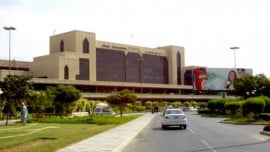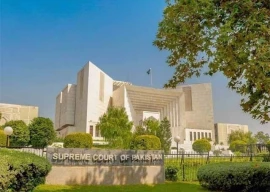
KARACHI:
With no new taxes and emphasis on completing the on-going projects, the bureaucrat-led Karachi Metropolitan Corporation (KMC) – in its first budget after 11 years – unveiled a Rs31.6 billion surplus budget for the upcoming fiscal year.
The city administration’s reliance on the provincial government was obvious as a major chunk of the budget is supposed to come from there in the shape of grants worth Rs12.8 billion. The new budget will have a surplus of Rs99.98 million, as the KMC estimates total revenues of Rs31.629 billion against its expenditures of Rs31.529 billion.
“We have limited resources,” said KMC Administrator Muhammad Hussain Syed while presenting the budget. “Whatever financial space we have, it is being used for development.”
He said some projects are facing delays due to lack of funds. “But we have put all the projects on the right track. The work has started. For example, we have issued tenders for new flyovers.”
The word “projects” came up many times during the budget speech, but there was hardly any mention of the hospitals, roads, bridges and parks constructed in the outgoing fiscal year. Even after the press conference, when the media confronted the administrator, he parried questions, laying all the blame on the lack of funds.
In his entire speech, Syed could mention only one achievement of the KMC: the construction of 10 pedestrian bridges at a cost of Rs160 million. No official was ready to explain how one such bridge could cost an average of Rs1.6 million, an amount enough to buy a decent property in Clifton. However, another Rs281 million have been allocated this year for the construction of more pedestrian bridges.
The highest amount of funds, Rs850 million, will go to the Karachi Circular Railway project. The KMC administrator claimed the circular railway is expected to start by September 2013. Shahabuddin Market and a parking plaza being constructed near Empress Market will take up Rs750 million, despite another car park building standing unused a stone’s throw away from the project. Around Rs100 million will be spent on the Fayzee Rahamin Art Gallery and Auditorium – another project supposed to have been completed years ago.
Work on Manghopir Road, Shahrah-e-Noor Jehan, 15,000 road, Hub River Road, Shahrah-e-Iran and other projects is either complete or nearing completion, said Syed. Interestingly, the major projects, which were mentioned for 2012-13, were all started in the previous years.
Throughout his speech, which was interlaced with praises for Sindh Governor Ishratul Ebad, Syed did not discuss the 191 development schemes that were to be completed by June 2012. He just said that Rs3 billion were spent on the completion of 152 schemes last year, while another Rs3.7 billion have been set aside for 85 major projects this year.
For development at the KDA Scheme 23 in Korangi, Rs625 million have been allocated with Rs522 million set aside for the KDA Scheme 36 in Gulistan-e-Jauhar and Rs520 million for KDA North Karachi Township. Similar amounts were allocated for these projects in the last budget also, but the city administration did not say how much of the work has been completed.
The poor performance of the KMC during the past year was obvious from the revenue statistics. Income from the municipal service charges and other local taxes has been estimated at Rs6.5 billion against the Rs9.6 billion estimated in the previous year.
The KMC will also construct a mausoleum for ghazal maestro Mehdi Hassan, who recently passed away. An amusement park will also be built in Hill Park under a public-private partnership.
Weeks before the budget was announced, the KMC had announced it was trying to raise revenue from charged parking, billboard advertisements and other taxes. However, the administrator made no mention of any such effort.
Some officials were of the view that the lack of interest was because officials were not sure about their own future. With constant talk of local body elections, officials are reluctant to take big decisions, which may be overturned by the elected council anyway.
Published in The Express Tribune, June 29th, 2012.
COMMENTS (1)
Comments are moderated and generally will be posted if they are on-topic and not abusive.
For more information, please see our Comments FAQ























































Low rise buildings cause sprawl. This leads to infrastructure needs that are ultimately unaffordable. This is a developing country reality within cities. In developed countries it can be seen in aged infrastructure in 'poor' areas within cities and in the inner ring suburbs-earlier suburbs with older infrastructure. The root cause is low rise development pattern.